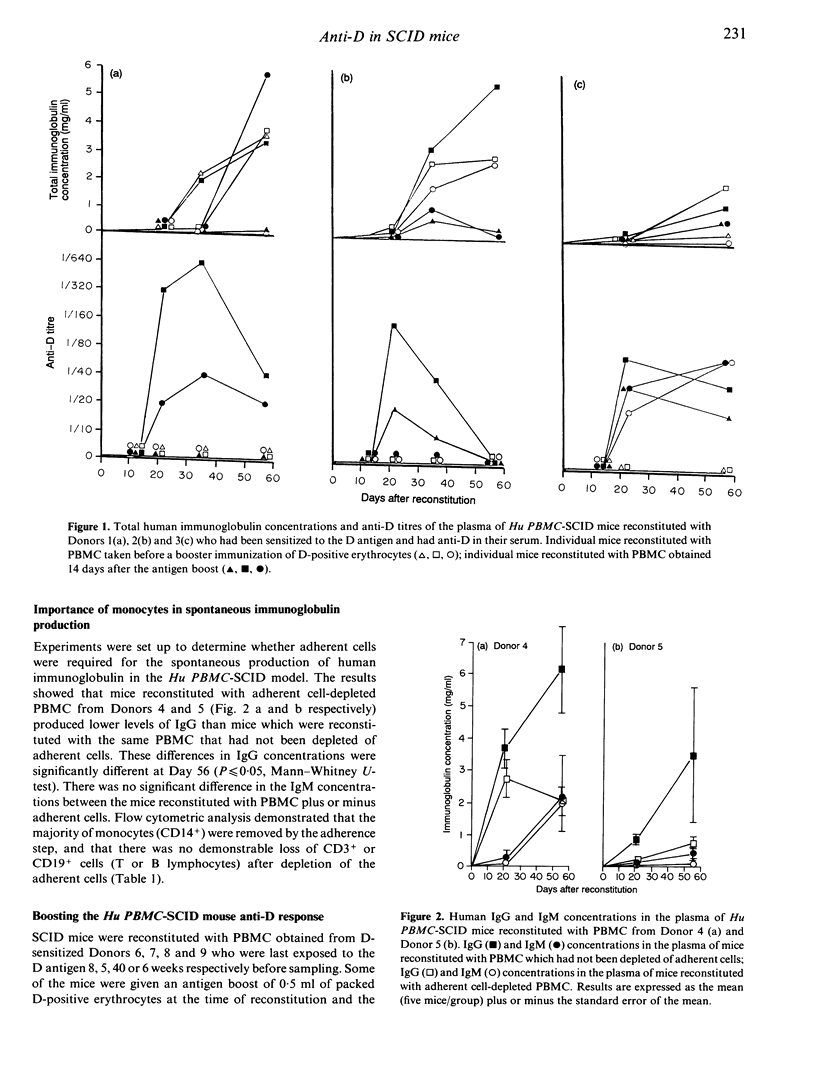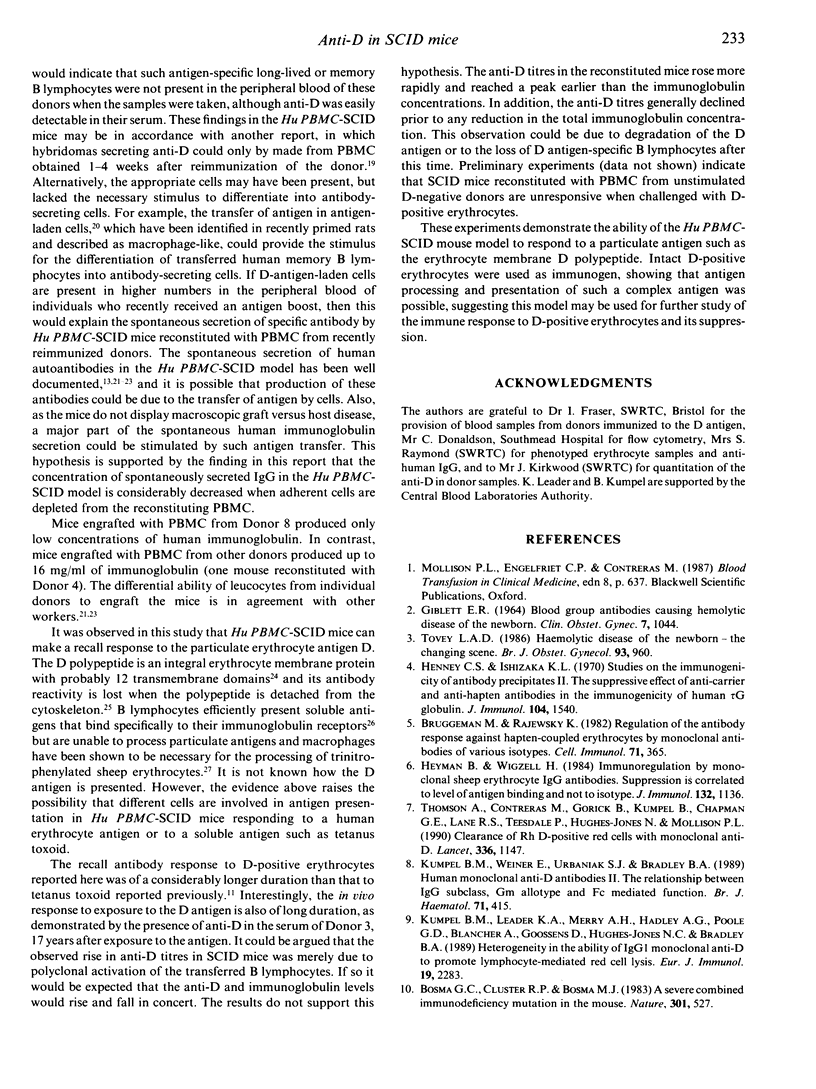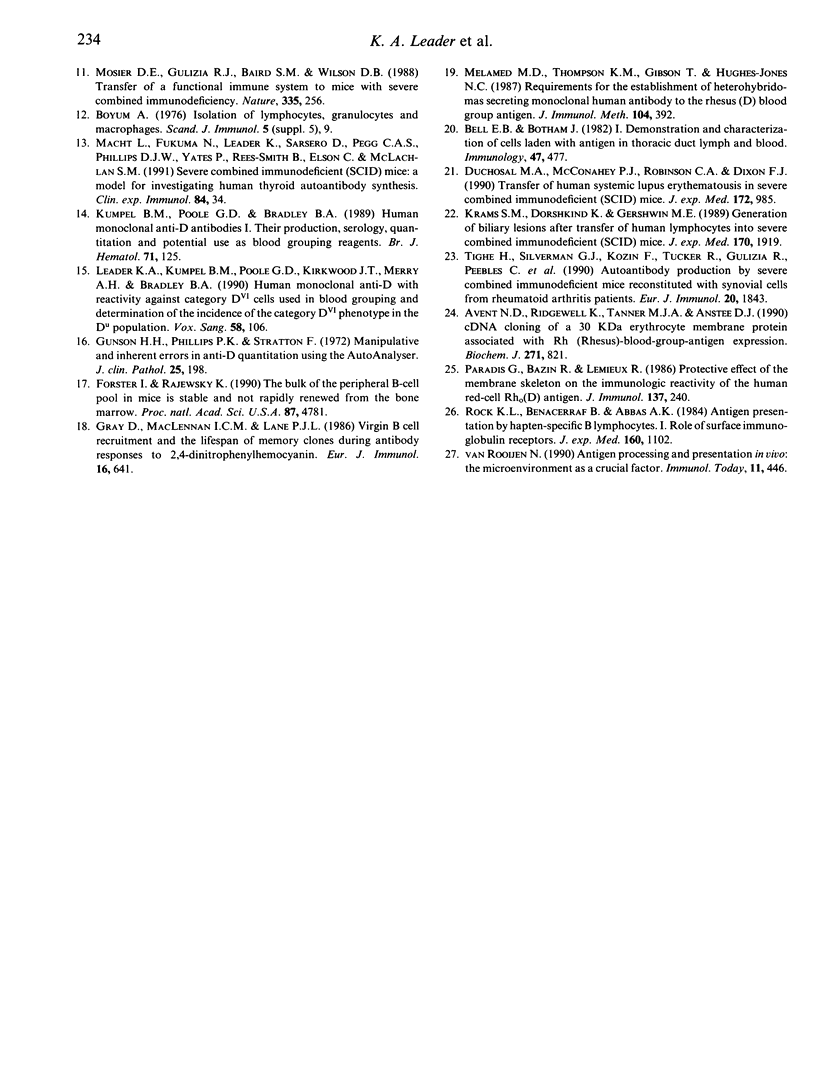Abstract
Mice with severe combined immunodeficiency (SCID) were reconstituted with peripheral blood mononuclear cells (PBMC) obtained from D-negative individuals who had been sensitized to D-positive erythrocytes. Anti-D was spontaneously secreted in mice reconstituted with PBMC obtained from donors within 14 days of re-immunization with D-positive erythrocytes, but was not detected in murine plasma when mice were reconstituted with PBMC obtained from the same donors many years after sensitization, even though anti-D was still present in the serum of these donors. In the murine plasma the anti-D titres were not related to the total human immunoglobulin concentrations. SCID mice reconstituted with PBMC from some donors immune to D-positive erythrocytes (but not immunized within 34 days of donating the sample) made a recall response to the D antigen, which in some cases was maintained for at least 84 days. Depletion of adherent cells from the reconstituting PBMC reduced the total concentration of human IgG obtained. These results show that SCID mice reconstituted with human PBMC (Hu PBMC-SCID) can make a recall response to the D antigen which cannot be attributed to non-specific polyclonal B-lymphocyte activation, and that efficient antigen processing and presentation of the integral erythrocyte membrane D polypeptide occurs in the Hu PBMC-SCID model.
Full text
PDF





Selected References
These references are in PubMed. This may not be the complete list of references from this article.
- Avent N. D., Ridgwell K., Tanner M. J., Anstee D. J. cDNA cloning of a 30 kDa erythrocyte membrane protein associated with Rh (Rhesus)-blood-group-antigen expression. Biochem J. 1990 Nov 1;271(3):821–825. doi: 10.1042/bj2710821. [DOI] [PMC free article] [PubMed] [Google Scholar]
- Bell E. B., Botham J. Antigen transport. I. Demonstration and characterization of cells laden with antigen in thoracic duct lymph and blood. Immunology. 1982 Nov;47(3):477–487. [PMC free article] [PubMed] [Google Scholar]
- Bosma G. C., Custer R. P., Bosma M. J. A severe combined immunodeficiency mutation in the mouse. Nature. 1983 Feb 10;301(5900):527–530. doi: 10.1038/301527a0. [DOI] [PubMed] [Google Scholar]
- Brüggemann M., Rajewsky K. Regulation of the antibody response against hapten-coupled erythrocytes by monoclonal antihapten antibodies of various isotypes. Cell Immunol. 1982 Aug;71(2):365–373. doi: 10.1016/0008-8749(82)90270-2. [DOI] [PubMed] [Google Scholar]
- Bøyum A. Isolation of lymphocytes, granulocytes and macrophages. Scand J Immunol. 1976 Jun;Suppl 5:9–15. [PubMed] [Google Scholar]
- Duchosal M. A., McConahey P. J., Robinson C. A., Dixon F. J. Transfer of human systemic lupus erythematosus in severe combined immunodeficient (SCID) mice. J Exp Med. 1990 Sep 1;172(3):985–988. doi: 10.1084/jem.172.3.985. [DOI] [PMC free article] [PubMed] [Google Scholar]
- Förster I., Rajewsky K. The bulk of the peripheral B-cell pool in mice is stable and not rapidly renewed from the bone marrow. Proc Natl Acad Sci U S A. 1990 Jun;87(12):4781–4784. doi: 10.1073/pnas.87.12.4781. [DOI] [PMC free article] [PubMed] [Google Scholar]
- GIBLETT E. R. BLOOD GROUP ANTIBODIES CAUSING HEMOLYTIC DISEASE OF THE NEWBORN. Clin Obstet Gynecol. 1964 Dec;10:1044–1055. doi: 10.1097/00003081-196412000-00012. [DOI] [PubMed] [Google Scholar]
- Gray D., MacLennan I. C., Lane P. J. Virgin B cell recruitment and the lifespan of memory clones during antibody responses to 2,4-dinitrophenyl-hemocyanin. Eur J Immunol. 1986 Jun;16(6):641–648. doi: 10.1002/eji.1830160609. [DOI] [PubMed] [Google Scholar]
- Gunson H. H., Phillips P. K., Stratton F. Manipulative and inherent errors in anti-D quantitation using the AutoAnalyzer. J Clin Pathol. 1972 Mar;25(3):198–205. doi: 10.1136/jcp.25.3.198. [DOI] [PMC free article] [PubMed] [Google Scholar]
- Henney C. S., Ishizaka K. Studies on the immunogenicity of antigen-antibody precipitates. II. The suppressive effect of anti-carrier and anti-hapten antibodies on the immunogenicity of dinitrophenylated human gamma G globulin. J Immunol. 1970 Jun;104(6):1540–1549. [PubMed] [Google Scholar]
- Heyman B., Wigzell H. Immunoregulation by monoclonal sheep erythrocyte-specific IgG antibodies: suppression is correlated to level of antigen binding and not to isotype. J Immunol. 1984 Mar;132(3):1136–1143. [PubMed] [Google Scholar]
- Krams S. M., Dorshkind K., Gershwin M. E. Generation of biliary lesions after transfer of human lymphocytes into severe combined immunodeficient (SCID) mice. J Exp Med. 1989 Dec 1;170(6):1919–1930. doi: 10.1084/jem.170.6.1919. [DOI] [PMC free article] [PubMed] [Google Scholar]
- Kumpel B. M., Leader K. A., Merry A. H., Hadley A. G., Poole G. D., Blancher A., Goossens D., Hughes-Jones N. C., Bradley B. A. Heterogeneity in the ability of IgG1 monoclonal anti-D to promote lymphocyte-mediated red cell lysis. Eur J Immunol. 1989 Dec;19(12):2283–2288. doi: 10.1002/eji.1830191216. [DOI] [PubMed] [Google Scholar]
- Kumpel B. M., Poole G. D., Bradley B. A. Human monoclonal anti-D antibodies. I. Their production, serology, quantitation and potential use as blood grouping reagents. Br J Haematol. 1989 Jan;71(1):125–129. doi: 10.1111/j.1365-2141.1989.tb06285.x. [DOI] [PubMed] [Google Scholar]
- Kumpel B. M., Wiener E., Urbaniak S. J., Bradley B. A. Human monoclonal anti-D antibodies. II. The relationship between IgG subclass, Gm allotype and Fc mediated function. Br J Haematol. 1989 Mar;71(3):415–420. doi: 10.1111/j.1365-2141.1989.tb04300.x. [DOI] [PubMed] [Google Scholar]
- Leader K. A., Kumpel B. M., Poole G. D., Kirkwood J. T., Merry A. H., Bradley B. A. Human monoclonal anti-D with reactivity against category DVI cells used in blood grouping and determination of the incidence of the category DVI phenotype in the DU population. Vox Sang. 1990;58(2):106–111. doi: 10.1111/j.1423-0410.1990.tb02071.x. [DOI] [PubMed] [Google Scholar]
- Mosier D. E., Gulizia R. J., Baird S. M., Wilson D. B. Transfer of a functional human immune system to mice with severe combined immunodeficiency. Nature. 1988 Sep 15;335(6187):256–259. doi: 10.1038/335256a0. [DOI] [PubMed] [Google Scholar]
- Paradis G., Bazin R., Lemieux R. Protective effect of the membrane skeleton on the immunologic reactivity of the human red cell Rho(D) antigen. J Immunol. 1986 Jul 1;137(1):240–244. [PubMed] [Google Scholar]
- Rock K. L., Benacerraf B., Abbas A. K. Antigen presentation by hapten-specific B lymphocytes. I. Role of surface immunoglobulin receptors. J Exp Med. 1984 Oct 1;160(4):1102–1113. doi: 10.1084/jem.160.4.1102. [DOI] [PMC free article] [PubMed] [Google Scholar]
- Thomson A., Contreras M., Gorick B., Kumpel B., Chapman G. E., Lane R. S., Teesdale P., Hughes-Jones N. C., Mollison P. L. Clearance of Rh D-positive red cells with monoclonal anti-D. Lancet. 1990 Nov 10;336(8724):1147–1150. doi: 10.1016/0140-6736(90)92767-c. [DOI] [PubMed] [Google Scholar]
- Tighe H., Silverman G. J., Kozin F., Tucker R., Gulizia R., Peebles C., Lotz M., Rhodes G., Machold K., Mosier D. E. Autoantibody production by severe combined immunodeficient mice reconstituted with synovial cells from rheumatoid arthritis patients. Eur J Immunol. 1990 Aug;20(8):1843–1848. doi: 10.1002/eji.1830200832. [DOI] [PubMed] [Google Scholar]
- Tovey L. A. Haemolytic disease of the newborn--the changing scene. Br J Obstet Gynaecol. 1986 Sep;93(9):960–966. doi: 10.1111/j.1471-0528.1986.tb08016.x. [DOI] [PubMed] [Google Scholar]


